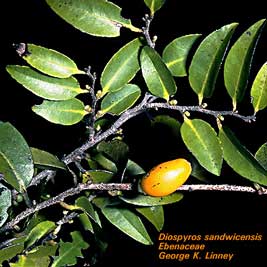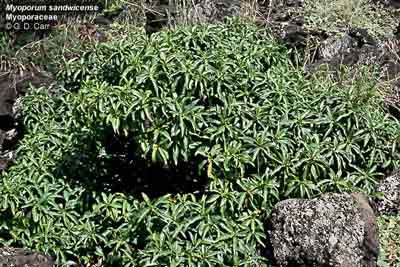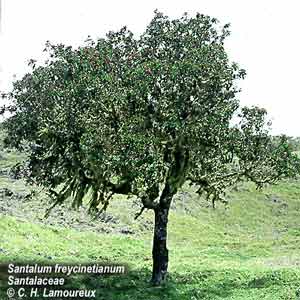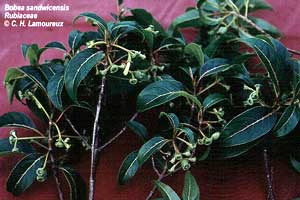|
|
|
|
|
|
Native
Plants: Lowland Dry and Mesic Forest
|
|
| The kula,
or native lowland dry and mesic forest, was the major ecosystem
in the ahupua'a of Nawiliwili Bay. It stretched, uninterrupted,
from the coastal zone to the wet forest in the back of Ha'iku.
. In the kula at
Nawiliwili Bay, these would have been the most common native
plants: |
|
Lowland Dry
and Mesic Forest uses plant photos courtesy
of the UH Botany Dept. Descriptive text is taken from How
to Plant a Native Hawaiian Garden - an on line handbook.
It also relies on Feathered Gods and Fishhooks by Patrick
V. Kirch, and Koamalu by Ethel Damon |
|
 |
|
 |
|
|
Lama - endemic (found nowhere
else in the world). The most frequent tree in the dry forest.
Lama wood is hard and light colored and is sacred to
Laka, goddess of hula. Ideal for house posts and as walls around
pa (sacred or important enclosures). |
|
|
|
|
|
|
|
Pili Grass - indigenous (naturally
occurring here and other places). It was the principal thatching
material for houses because it has a pleasant aroma and pili
(clings) to the house framework. |
|
|
|
|
|
|
|
|
|
|
|
|
|
|
|
|
|
Wilwili - Ancient Hawaiians
used the light wood for fish net floats, surfboards, and canoe
outrigger floats (ama). Endemic to arid lowlands and
dry forests on all main islands. The abundance of wiliwili
trees at Nawiliwili Bay was the source of its name. |
|
|
|
|
|
|
|
|
Ala'a - endemic
|
|
|
| 'Ohe - endemic.
Because it is host to more native insects than any other native
tree, 'ohe is thought to be one of the first trees to
arrive in Hawai'i. |
|
|
|
|
|
|
 |
Naio- Naio inhabits a wide range of ecological
habitats: beaches, lowlands, dry forests, semi-dry forests,
and subalpine forests up to 7500 feet elevation. Ancient Hawaiians
used the hard, yellowish wood for house frames. It was unsuccessfully
substituted for sandalwood during the waning days of the sandalwood
trade.
|
|
Indigenous to all the main islands
of Hawai`i except for possibly Kaho`olawe. |
|
|
|
|
|
|
|
|
 |
'Iliahi - endemic. This is the fragrant variety harvested
and shipped to China. It was abundant in lowland mesic forest,
like the ahupua'a of Nawiliwili Bay. 'Iliahi is a partial
parasite, as it absorbs nutrients from the roots of nearby plants.
Only the heartwood has the oil that produces it's wonderful
fragrance. |
|
|
|
|
|
|
|
|
'Ahakea - endemic. In the
mid 1800's, the forest between Hanamaulu and Nawiliwili was
mostly hau, 'ahakea, koa, and kukui.
(Ethel Damon) |
|
 |
|
|
|
|
 |
|
Koa - endemic. Below the equator, koa refers to the
ironwood tree. Hawaiian settlers applied this name to our endemic
koa tree because it had the same uses as the ironwood.
(Patrick V. Kirch) |
|
|
|
|
|
 |
Loulu - endemic varieties on each island. The leaves of
native loulu were once used for thatching. Young bleached leaves
were used for weaving hats, fans, and baskets. Marie C. Neal
also reported that Hawaiians ate the unripe seeds, hawane or
wahane, which tasted somewhat like coconut. It is now thought
that loulu grew in abundance along the streams at Nawilwili
Bay. |
|
|
|
Today, the native lowland mesic forest
has nearly been replaced with introduced plants (like haole
koa and Java plum), or sugar plantations. This was the main
area occupied and changed by Hawaiian settlers. However, the
wet forest has survived
relatively intact to the present day. For the Hawaiian settlers,
this was the wao akua (traditional
realm of Hawaiian gods), and not for ordinary humans. |
|
|
|
|
|
|
|
|
|
|
|
|
|
|
|

